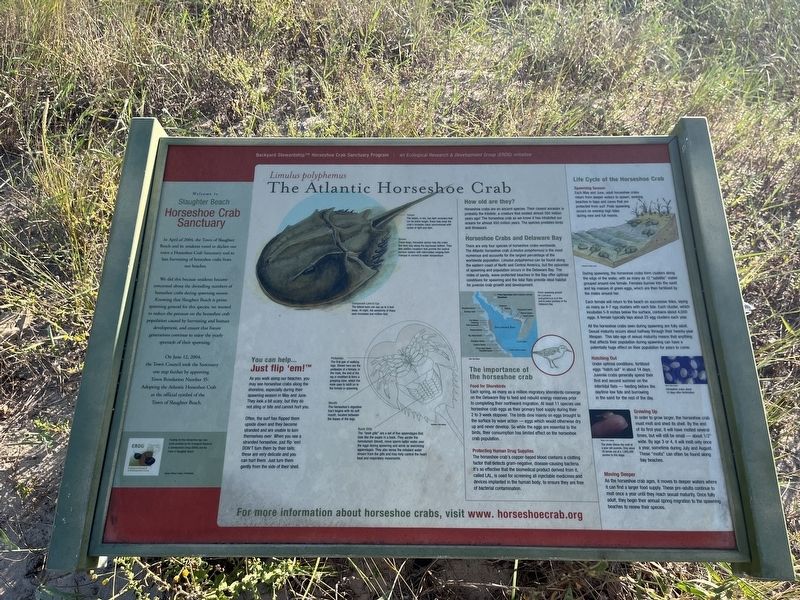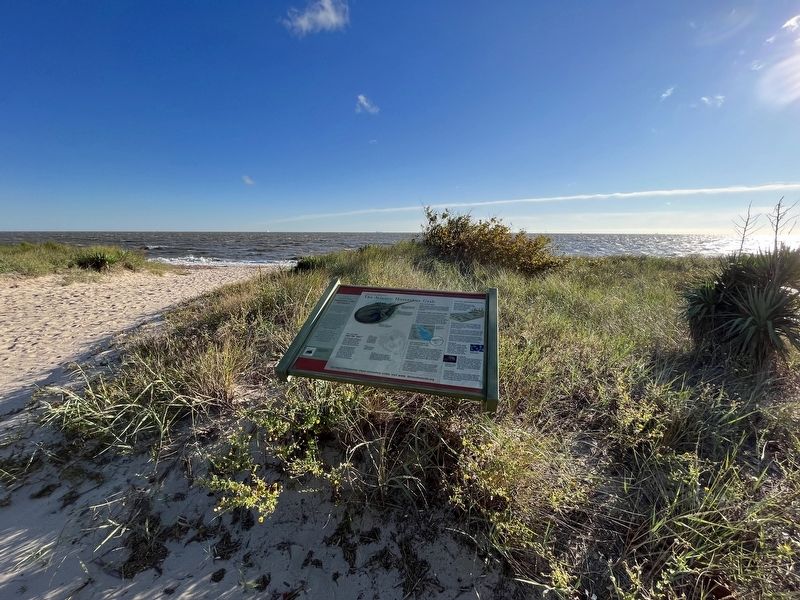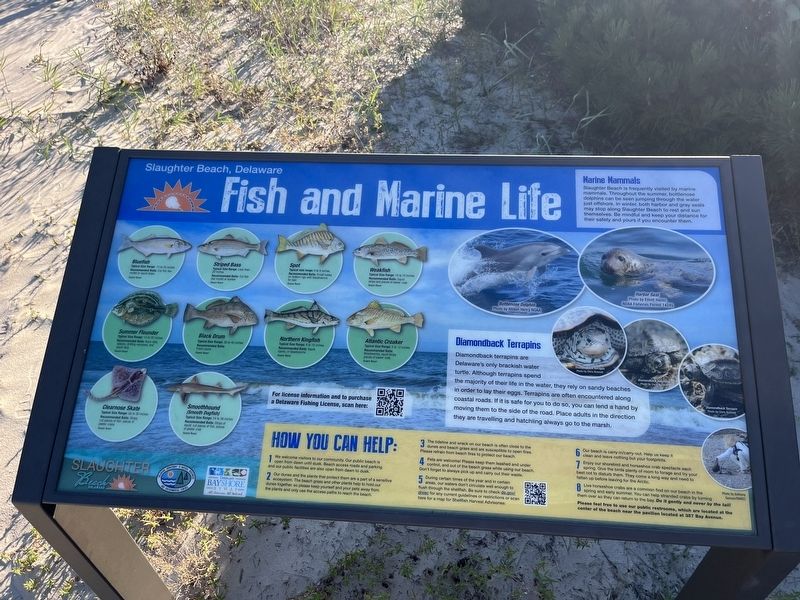Slaughter Beach in Sussex County, Delaware — The American Northeast (Mid-Atlantic)
The Atlantic Horseshoe Crab
Limulus polyphemus
— Backyard Stewardship Horseshoe Crab Sanctuary Program —
Welcome to Slaughter Beach Horseshoe Crab Sanctuary
In April of 2004, the Town of Slaughter Beach and its residents voted to declare our town a Horseshoe Crab Sanctuary and to ban harvesting of horseshoe crabs from our beaches.
We did this because residents became concerned about the dwindling numbers of horseshoe crabs during spawning season. Knowing that Slaughter Beach is prime spawning ground for this species, we wanted to reduce the pressure on the horseshoe crab population caused by harvesting and human development, and ensure that future generations continue to enjoy the yearly spectacle of their spawning.
On June 12, 2004, the Town Council took the Sanctuary one step farther by approving Town Resolution Number 35: Adopting the Atlantic Horse Crab as the official symbol of the Town of Slaughter Beach.
You can help…
Just flip em!
As you walk along our beaches, you may see horseshoe crabs along the shoreline, especially during their spawning season in May and June. They look a bit scary, but they do not sting or bite and cannot hurt you.
Often, the surf has flipped them upside down and they become stranded and are unable to turn themselves over. When you see a stranded horseshoe, just flip 'em! Don't turn them by their tails; these are very delicate and you can hurt them. Just turn them gently from the side of their shell.
How old are they?
Horseshoe crabs are an ancient species. Their closest ancestor is probably the trilobite, a creature that existed almost 500 million years ago! The horseshoe crab as we know it has inhabited our oceans for 450 million years. The species predates birds and dinosaurs.
Horseshoe Crabs and Delaware Bay
There are only species of horseshoe crabs worldwide. The Atlantic horseshoe crab (Limulus polyphemus) is the most numerous and accounts for the largest percentage of the worldwide population. Limulus polyphemus can be found along the eastern coast of North and Central America, but the epicenter of spawning and population occurs in the Delaware Bay. The miles of sandy, wave protected beaches in the Bay offer optimal conditions for spawning and the tidal flats provide ideal habitat for juvenile crab growth and development.
The importance of the horseshoe crab
Food for Shorebirds
Each spring, as many as a million migratory shorebirds converge on the Delaware Bay to feed and rebuild energy reserves prior to completing their northward migration. At least 11 species use horseshoe crab eggs as their primary food supply during their 2 to 3 week stopover. The birds dine mainly on eggs brought to the surface by wave action — eggs which would otherwise dry up and never develop. So while the eggs are essential to the birds, their consumption has limited effect on the horseshoe crab population.
Protecting Human Drug Supplies
The horseshoe crab's copper-based blood contains a clotting factor that detects gram-negative, disease-causing bacteria. It's so effective that the biomedical product derived from it, called LAL, is used for screening all injectable medicines and devices implanted in the human body, to ensure they are free of bacterial contamination.
Life Cycle of the Horseshoe Crab
Spawning Season
Each May and June, adult horseshoe crabs return from deeper waters to spawn, seeking beaches in bays and coves that are protected from surf. Peak spawning occurs on evening high tides during new and full moons.
During spawning, the horseshoe crabs form clusters along the edge of the water, with as many as 12 "satellite" males grouped around one female. Females burrow into the sand and lay masses of green eggs, which are then fertilized by the males around her.
Each female will return to the beach on successive tides, laying as many as 4-7 egg clusters with each tide. Each cluster, which incubates 5-8 inches below the surface, contains about 4,000 eggs. A female typically slays about 25 egg clusters each year.
All
the horseshoe crabs seen during spawning are fully adult. Sexual maturity occurs about halfway through their twenty-year lifespan. This late-age of sexual maturity means that anything that affects their population during spawning can have a potentially huge effect on their population for years to come.
Hatching Out
Under optimal conditions, fertilized eggs "hatch out" in about 14 days. Juvenile crabs generally spend their first and second summer on the intertidal flats — feeding before daytime low tide and burrowing in the sand for the rest of the day.
Growing Up
In order to grow larger, the horseshoe crab must molt and shed its shell. By the end of its first year, it will have molted several times, but will still be small — about 1/2" wide. By age 3 or 4, it will molt only once a year, sometime during July and August. These "molts" can often be found along bay beaches.
Moving Deeper
As the horseshoe crab ages, it moves to deeper waters where it can find a larger food supply. These pre-adults continue to molt once a year until they reach sexual maturity. Once fully adult, they begin their annual spring migration to the spawning beaches to renew their species.
Erected by Ecological Research & Development Group and the Town of Slaughter Beach.
Topics. This historical marker is listed in these topic lists: Animals • Environment • Waterways & Vessels. A significant historical month for this entry is April 2004.
Location. 38° 54.821′ N, 75° 18.273′ W. Marker is in Slaughter Beach, Delaware, in Sussex County. Marker is on Bay Avenue (County Road 204) north of Pavilion Street, on the right when traveling north. Touch for map. Marker is at or near this postal address: 357 Bay Ave, Milford DE 19963, United States of America. Touch for directions.
Other nearby markers. At least 8 other markers are within 7 miles of this marker, measured as the crow flies. The Memorial Vol. Fire Co. (within shouting distance of this marker); Birds (approx. one mile away); Fort Saulsbury (approx. 2.3 miles away); Slaughter Neck United Methodist Church (approx. 3.6 miles away); a different marker also named The Atlantic Horseshoe Crab (approx. 5.2 miles away); Absalom Jones (approx. 5.4 miles away); Cedar Creek Hundred (approx. 6.1 miles away); Observation Tower at Big Stone Beach (approx. 6.1 miles away). Touch for a list and map of all markers in Slaughter Beach.
Additional commentary.
1. About the marker
While the majority of the marker describes the biology of the horseshoe crab, it also serves as a historical marker because it shares how the Town of Slaughter Beach became involved in protecting the species.
— Submitted September 17, 2023, by Devry Becker Jones of Washington, District of Columbia.
Credits. This page was last revised on September 17, 2023. It was originally submitted on September 17, 2023, by Devry Becker Jones of Washington, District of Columbia. This page has been viewed 74 times since then and 37 times this year. Photos: 1, 2, 3. submitted on September 17, 2023, by Devry Becker Jones of Washington, District of Columbia.


